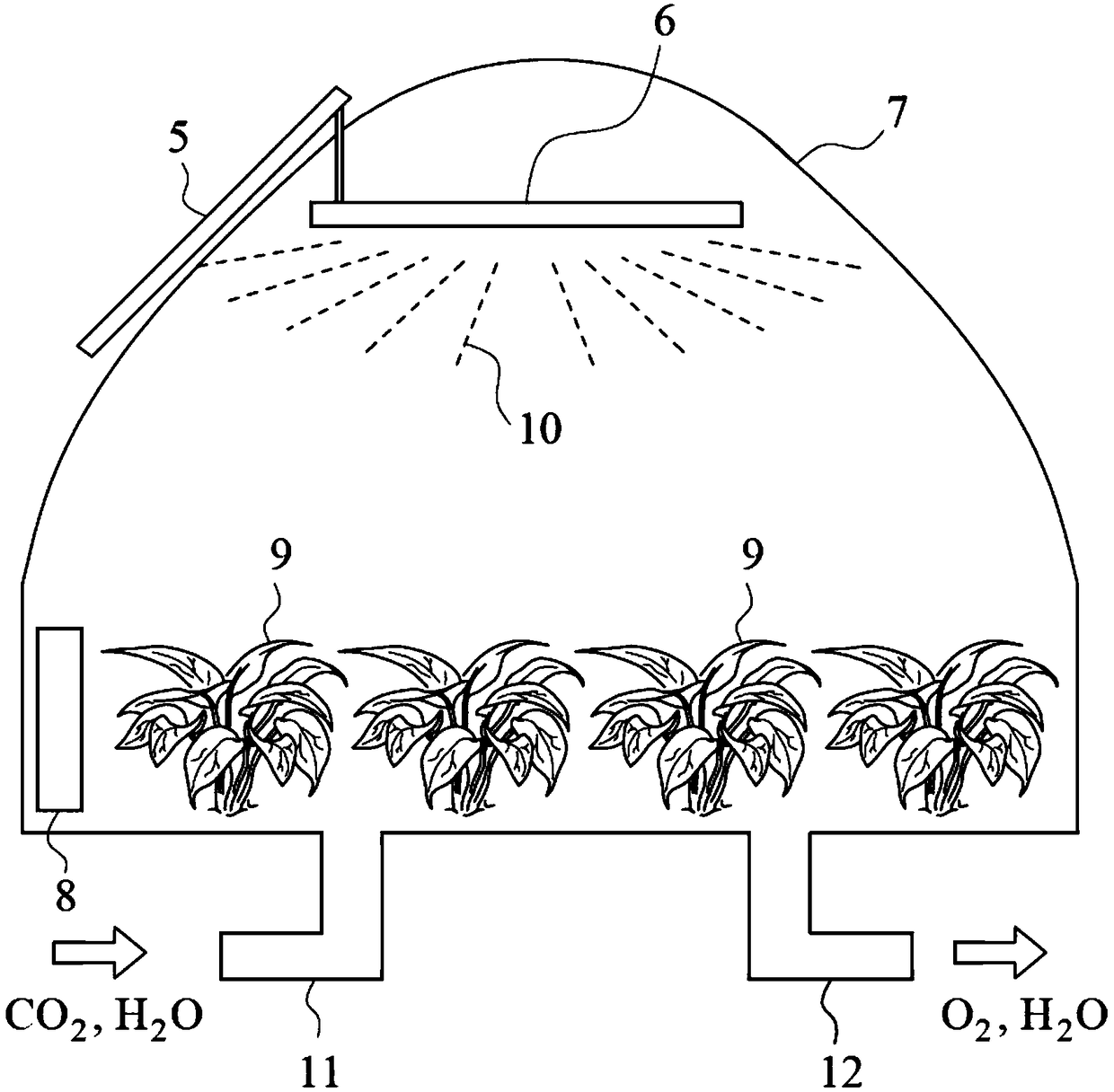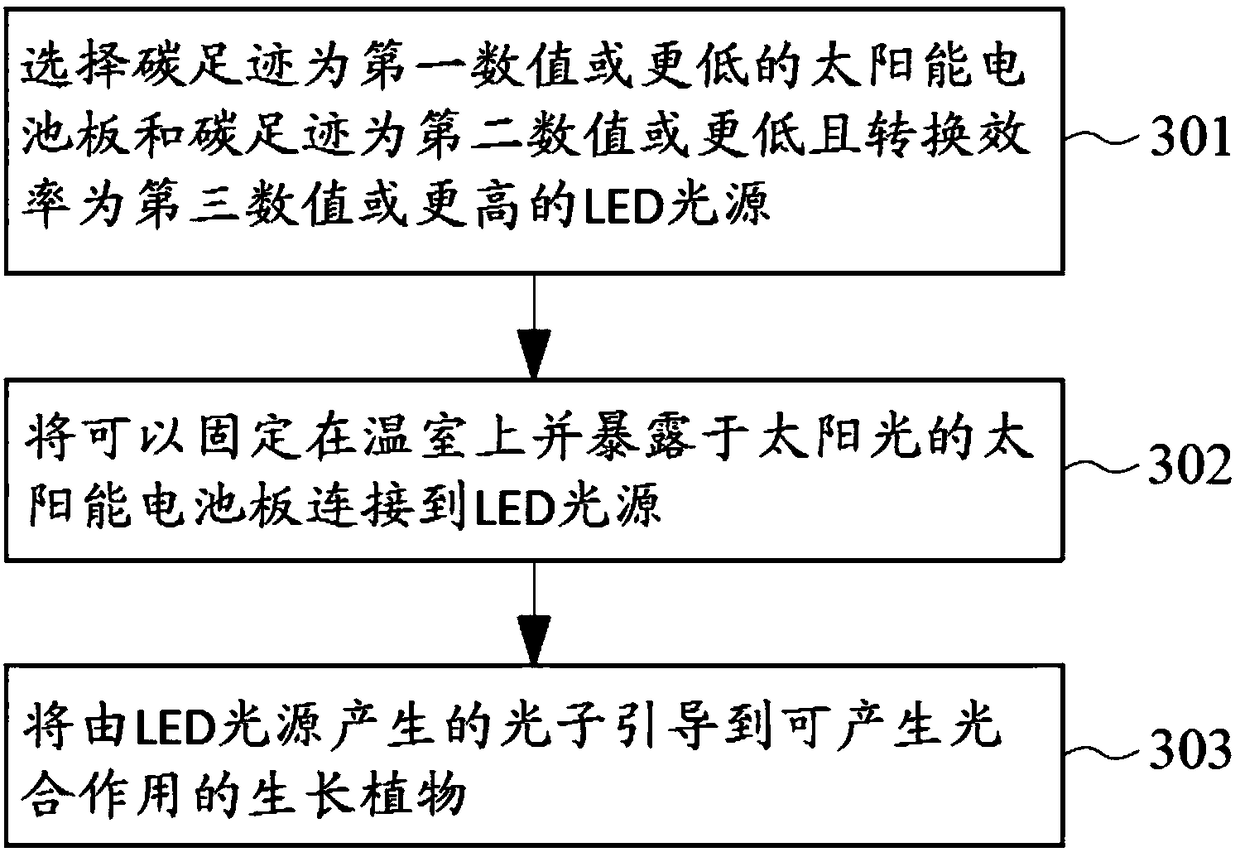Negative carbon emission system and method thereof
An emission system and negative carbon technology, applied in horticultural methods, botanical equipment and methods, energy saving and emission reduction, etc., can solve problems such as rising net carbon dioxide concentration
- Summary
- Abstract
- Description
- Claims
- Application Information
AI Technical Summary
Problems solved by technology
Method used
Image
Examples
example 1
[0077] figure 1 Depict the components that implement the carbon negative emission system of the present invention. Assembly 1 depicts a solar panel that can be positioned to face the sun. Assembly 2 depicts an LED light source, which in an embodiment is arranged to shine directly on growing vegetation 4 like eg algae. Assembly 3 depicts the battery connected to the solar panel 1 and the LED light source 2 . Assembly 3 may include a voltage converter that converts the DC voltage from the solar panel into AC voltage.
[0078] As mentioned earlier, both solar panels and LED light sources come with their own carbon footprint. According to the inventor's calculations, First Solar's exemplary solar panel has a carbon footprint of 6.15g CO 2 e / KWh while Osram's exemplary LED has 3.65g CO 2 Carbon footprint in e / KWh. As analyzed earlier in this article, when the LED light source guides the growing plants, the combination of the solar panel and the LED light source can eliminate ...
example 2
[0080] figure 2 Depicting another embodiment of the invention, the system comprises solar panels 5 fixed to a greenhouse 7 in which photosynthetic plants such as algae grow. Solar panels with a carbon footprint of 6.15 gCO2e / kWh or less, connected directly to an LED light source6, or indirectly via a battery, as shown in component 8, with an LED carbon footprint of 3.65 gCO2e / kWh or less few. When photons 10 are directed to growing plants 9 including algae, this system is not only capable of eliminating CO from the combination of solar panels and LED light sources 2 Emissions can remove more carbon dioxide from the atmosphere. Assembly 8 includes an optional voltage converter that converts the DC voltage from the solar panel to AC voltage. also, figure 2The shown system may also include: a first air guide system 11 for introducing carbon dioxide and moisture to provide to the growing plants; a second air guide system 12 for exporting the oxygen produced by the growing pl...
example 3
[0082] image 3 Describe the construction process by which a carbon negative emission system can be achieved. The process includes the following steps. Step 301, select the carbon footprint as the first value such as 6.15g CO 2 e / KWh or lower solar panels and carbon footprint as a second value eg 3.65g CO 2 An LED light source with e / KWh or lower and a conversion efficiency of a third numerical value such as 30.4% or higher. At step 302, a solar panel, which may be fixed on the greenhouse and exposed to sunlight, is connected to the LED light source, wherein the solar panel may also be connected to the LED light source through a battery and a converter. In step 303, the photons generated by the LED light source are guided to photosynthetic growing plants such as algae, and the surface of the algae can absorb most of the photons. In addition, the following steps may be further added: providing a first air guide system for introducing carbon dioxide and moisture to the growi...
PUM
 Login to View More
Login to View More Abstract
Description
Claims
Application Information
 Login to View More
Login to View More - R&D
- Intellectual Property
- Life Sciences
- Materials
- Tech Scout
- Unparalleled Data Quality
- Higher Quality Content
- 60% Fewer Hallucinations
Browse by: Latest US Patents, China's latest patents, Technical Efficacy Thesaurus, Application Domain, Technology Topic, Popular Technical Reports.
© 2025 PatSnap. All rights reserved.Legal|Privacy policy|Modern Slavery Act Transparency Statement|Sitemap|About US| Contact US: help@patsnap.com



